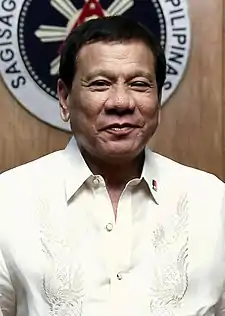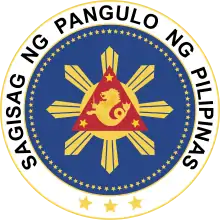2018 Boracay closure and redevelopment
On April 26, 2018, the Philippine resort island of Boracay, one of the country's major tourist destinations, was temporarily closed to the general public as part of the government's efforts to rehabilitate and redevelop the island. As part of the closure, Boracay was closed for six months except to its registered residents and employees.
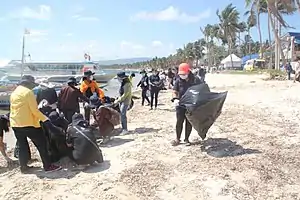 Volunteers from the DENR Region 6 conducting a cleanup in Bulabog Beach. April 26, 2018. | |
| Date | April 26 – October 26, 2018 |
|---|---|
| Duration | 6 months |
| Location | Boracay, Malay, Aklan, Philippines |
| Type | Closure / rehabilitation |
| Cause | Violations of building and sewerage regulations by business establishments, deteriorating environmental conditions |
Background

In a business forum held on February 9, 2018, President Rodrigo Duterte called the island of Boracay a "cesspool" and announced plans to close the island to tourists and conduct a rehabilitation on the island in June 2018 to resolve the worsening sewage conditions there. Duterte has directed Environment secretary Roy Cimatu to resolve the environmental issues in the island.[1] Boracay is part of the jurisdiction of the town of Malay of Aklan province. Three of Malay's barangays are in Boracay.[2]
According to the Western Visayas regional office of the Department of Tourism, Boracay had two million tourists in 2017 which accounts for 34 percent of Western Visayas' 5.8 million tourist arrivals. At least 19,031 are employed to work on the island.[3]
Department of Environment and Natural Resources (DENR) Ecosystems Research and Development Bureau, together with the University of the Philippines at Los Baños, Laguna, had earlier commissioned a study to compute Boracay's "real carrying capacity". The study took into account Boracay land area, hours spent on activities on the island and other environmental factors. According to the study, Boracay can accommodate only a total of 54,945 people at a time, broken down into 19,215 tourists and 35,730 residents, which includes 22,395 stay-in workers. However, Boracay's existing population of more than 70,700 had already exceeded the carrying capacity by almost 30%.[4] Given the excess one-third capacity, the DENR is looking to relocate some 6,000 workers to mainland Malay town in Aklan.[5] DENR is also exploring the option of having hotels and establishments to subsidize the living and transport expenses or to house their own workers. Other alternative includes the provision of a new port for workers and permanent residents to avoid congestion in the existing one, which will be ring-fenced for tourist use.[6]
Waters along the beaches of Boracay have experienced algal bloom which environmentalists and some long-time residents claim to be an indicator of pollution and deteriorating water conditions. The Malay municipal government, some business operators, and some residents insist that the algal bloom is a natural seasonal phenomenon that usually occurs annually in the summer, and occurred on Boracay even before the island became developed.[2]
Boracay Island Water Co. operates the sewage network of Boracay which accommodates only 61 percent of the island. The island has two central sewerage treatment plants with a total a total capacity of 11.5 million liters/day, one in Barangay Balabag and another in Barangay Manoc-Manoc, and plans the construction of a third plant in Barangay Yapak with a capacity of 5 million litres/day. This addition will allow more establishments in the Balabag area to connect to the sewer system. Without this addition, only 58 percent of the capacity is used.[7]
Events leading to the closure
Following Rodrigo Duterte's comment on the situation in Boracay, the local government of Malay issued a statement on February 19, 2018 accepting the remarks by the president as "constructive criticism" and acknowledged the environmental issues affecting the island. It pointed out that the municipal government had entered in a partnership with architectural firm, Palafox Associates to formulate a tourism municipal master plan which involved decongesting Boracay and implementing building regulations in the island. In addition it criticized ABS-CBN and GMA Network for using photos of algal bloom in the island to "sensationalize" the algal phenomenon in the island which it insists as natural and says it only occurs in the summer.[2]
There were repeat calls for a partial closure of Boracay instead of a total closure. 1-Pacman partylist has proposed the closure of areas identified as medium to high risk based primarily on environmental and sanitary standards while low risk areas were to operate while the rest of the island was being rehabilitated.[8]
The military also to deployed to secure Boracay during its closure as support to the local police. Protest actions were the "foremost threat" the security forces were stated to be anticipating.[9]
Planned media coverage restriction
The Department of Interior and Local Government announced that journalists would need permission to cover the shutdown of Boracay.[10] On April 14, 2018, the Department of Tourism of the Philippines issued guidelines that sought to limit media coverage of the Boracay shutdown. According to the media accreditation guidelines, television networks would be limited to 12 persons, while radio, print, and online organizations and wire services would be limited to five persons.[11] Accredited organizations would be allowed on the island from 8 a.m. to 5 p.m., restricted to designated areas,[10] and required to be escorted.[12] "Vetting and processing" of applications for accreditation would take three to five working days.[11]
The Center for Media Freedom and Responsibility (CMFR) noted criticisms that saw the guidelines "as government’s way to prevent access to critical media, selectively favoring the media practitioners who are friendly to government."[11] The National Union of Journalists of the Philippines called the restrictions unconstitutional.[10] The CMFR said the accreditation system was a form of prior restraint,[13] and noted a wider pattern of restrictions that sought to limit press freedom in the Philippines.[11][13]
On April 25, 2018, the Department of Tourism announced that it was dropping the requirement for accreditation for media coverage.[12]
Closure and rehabilitation
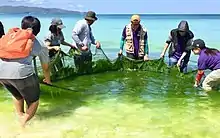
On April 4, 2018, the Philippine government announced that Boracay would be closed for up to six months starting on April 26.[14] Checkpoints manned by police officers and soldiers would be set up at piers in Boracay to turn away visitors from the island. Passes would be given to local residents.[15]
On the day of the closure, President Rodrigo Duterte declared a state of calamity over the three barangays of Boracay.[16]
The Department of Social Welfare and Development (DSWD) has distributed relief goods to residents of Boracay while the island is closed to tourists. In June 2018, there were reports of residents receiving spoiled canned goods. The DSWD has admitted mishandling the relief efforts, apologize, and vowed to investigate the matter.[17]
Within the same month, a whale shark sighting was reported in Boracay through social media. Social media users mostly from Aklan hailed the sightings as a good sign.[18] The government through presidential spokesperson Harry Roque said that the sighting is a proof that the rehabilitation is a success.[19] Greenpeace however responded to that the whale shark sighting is not an indicator of success of the cleanup efforts pointing out that whale sharks are migratory creatures and claimed that the animal is a normal occurrence in Boracay. It criticized the government for using the sighting as a metric for the rehabilitation.[20]
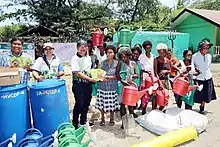
The government in June 2018 announced that it is developing the Ati people's 2 ha (4.9 acres) ancestral land in Boracay into an agro-tourism area in an effort to integrate the Ati in the island's tourism industry. The development is part of the Department of Agriculture's Kabuhayan at Kaunlaran ng Kababayang Katutubo (transl. Livelihood and Progress of Filipino Indigenous Peoples; 4Ks) program which was conceptualized by the department's secretary Emmanuel Piñol. A greenhouse will be set up for vegetable cultivation and a goat farm for the production of milk. An organic restaurant serving Ati cuisine and hostel will also be set up[21] along the beach area to be run by members of the Ati people.[22]
The last batch of livelihood aid from the DSWD was distributed to Boracay residents on September 21. A total of ₱158.9 million worth of aid was given to residents affected by the closure.[23]
From October 16 to 25, 2018, Boracay was partially opened or have a dry run of its return to tourism operations. Filipino citizens were only allowed to visit the island as tourists with locals given priority. Assessment was made before Boracay was fully reopened on its soft opening on October 26.[24]
Post-closure rehabilitation
Despite Boracay's soft opening to tourism on October 26, 2018, rehabilitation works were scheduled to continue on the island with its first phase to complete within October 2018. The second phase of rehabilitation was projected to last until mid-2019 and the third phase until the end of 2019.[24] Visitor numbers were quite restricted and many new regulations instituted.[25]
The Department of Energy (DOE) donated 200 electric tricycles to the Malay local government in Aklan to improve the public transport system, embarking on "more sustainable tourism development for the island".[26]
Legal case
On June 27, 2018, the Department of Interior and Local Government (DILG) filed a complaint against 17 executive officials including Aklan Governor Florencio Miraflores and Malay Municipal Mayor Ciceron Cawaling over neglect over Boracay. The officials were alleged to have been lax in issuing building permits and to have failed to sufficiently tackle illegal development activities on the island.[27]
Impact
About 400 hotels and restaurants were ordered to close for violating local environmental laws, while 3 casinos have been permanently shut down. Establishments built within the 30-meter shoreline easement were also demolished.[28]
The government projected that there will be about ₱18–20 billion loss of potential gross receipts as a result of the six months closure of Boracay.[29] Tourist stakeholders in the island project a loss of ₱30 billion as they estimate that 700,000 bookings by foreign tourists were cancelled in anticipation of the closure.[30]
Philippine Airlines, Cebu Pacific and AirAsia Philippines have announced that they will reduce flights to and from Kalibo International Airport in Kalibo and Godofredo P. Ramos Airport in Caticlan during the closure.[30]
One estimate placed the number of jobs to be lost at 36,000, with lost revenues at ₱56 billion.[31]
As a result of the closure, the Boracay police recorded only 14 index crimes from April 26 to June 22, 2018 as opposed 176 cases during the same period the previous year.[32]
Following Boracay's six-month closure for rehabilitation, the Department of Tourism issued a warning on October 19 to local government units based in 5 major tourist destinations to follow environmental laws, namely El Nido in Palawan, Panglao in Bohol, Oslob in Cebu, La Union, and Baguio.[33]
Reform
Land use
On May 30, 2018, President Duterte declared that he planned to make the entire Island of Boracay a land reform area and wanted to prioritize Boracay's first inhabitants.[34][35]
Tourism regulations
The Department of Environment and Natural Resources conducted a study which concludes that the ideal number of people Boracay island can accommodate is 60,000 people. At that given population it is estimated that the island could produce nine tons of garbage at average. In lieu of this, the agency is working with the local government of Malay and other stakeholders to come up with new regulations once Boracay is opened again to tourists. The DENR would only allow for 19,000 tourists to visit the island daily. If the limit is exceeded, only allow tourists with hotel reservations would be allowed but their respective hotels would be alerted by the agency that the daily limit of tourists in the island has already been reach.[36] However it was later clarified that the government has yet to finalize the daily tourist limit to be imposed on Boracay.[24]
The Department of Tourism would also prohibit smoking and drinking of alcohol in public places and the beaches of Boracay though these activities would be allowed in designated areas. This was done in an effort to reduce cigarette butts and shards from broken alcohol bottles in beaches. Large scale parties such as the "Laboracay", which draws in 60,000 to 70,000 tourists in three days, would no longer be allowed in the island.[37]
Under the new rules, 19,200 tourists per day will be allowed on the island. Moreover, fire eaters, masseuses, vendors, stray dogs, bonfires and even the builders of photo-op sandcastles have been banned from the beachfront. All water sports, aside for swimming, are also forbidden for the time being.[28]
Sustainable tourism development through green transportation
To further support the rehabilitation efforts on Boracay Island, the Department of Energy (DOE), in partnership with Department of Transportation (DOTr) and local government unit of Malay, signed a Memorandum of Agreement on October 15, 2018 for the donation of 200 energy efficient electric tricycles (e-trike). These e-trikes are set to gradually replace the gasoline-powered tricycles on the island for a "greener public transportation", and are also seen as the way forward to reduce the vulnerability of the country on the volatility of international oil price movements and other economic impacts.
One of the major beneficiaries of the e-trike project would be the Boracay Ati Tribal Organization (BATO) in coordination with the National Commission on Indigenous Peoples. A total of 10 e-trikes will be given to the BATO, which were intended for their livelihood.[38]
References
- "Duterte calls Philippine tourist island Boracay a 'cesspool'". The Star Online. February 10, 2018. Retrieved April 9, 2018.
- Burgos, Nestor Jr. (February 19, 2018). "Town gov't accepts Boracay 'cesspool' tag as 'constructive criticism'". Inquirer Visayas. Retrieved April 9, 2018.
- Burgos, Nestor Jr. (March 23, 2018). "Tourists calling off Boracay trips amid closure plans". Philippine Daily Inquirer. Retrieved April 9, 2018.
- "Task Force adopts guidelines to protect Boracay VS tourist influx". Department of Environment and Natural Resource. Retrieved March 12, 2019.
- "IN CHARTS: Boracay is bursting at the seams". Rappler. Retrieved March 12, 2019.
- "They outnumber tourists! Over 15,000 workers to be booted out of Boracay". Rappler. Retrieved March 12, 2019.
- "Boracay Water investing P1.15B for sewerage treatment plant". Panay News. June 25, 2018. Retrieved June 28, 2018.
- Diaz, Jess (August 1, 2018). "Partial closure of Boracay Island pushed anew". The Philippine Star. Retrieved April 9, 2018.
- "Soldiers sent to secure Boracay – The Freeman". The Philippine Star.
- Yap, Tara (April 17, 2018). "Boracay coverage restrictions 'illogical' – NUJP". Tempo. Retrieved May 17, 2018.
- "Pattern of Restrictions Signals Crackdown on PH Press". CMFR. May 7, 2018. Retrieved May 17, 2018.
- Burgos Jr., Nestor P. (April 26, 2018). "Task force scraps restrictions on media coverage of Boracay during closure". Philippine Daily Inquirer. Retrieved May 17, 2018.
- "The DOT Accreditation System: A Form of Prior Restraint". CMFR. April 19, 2018. Retrieved May 17, 2018.
- Ronda, Rainier Allan; Ong, Ghio; Romero, Alexis (April 5, 2018). "Boracay closed for 6 months effective April 26". The Philippine Star. Retrieved April 9, 2018.
- "Boracay closure creates chaos on the island". The Manila Times. Agence France-Presse. April 7, 2018. Retrieved April 9, 2018.
- Corrales, Nestor (April 26, 2018). "Duterte declares state of calamity in Boracay". Philippine Daily Inquirer. Retrieved April 26, 2018.
- Jalea, Mary Gleefer (June 26, 2018). "DSWD admits mishandling spoiled Boracay relief goods". The Manila Times. Retrieved June 28, 2018.
- "Whale shark in Boracay a 'good sign'". Panay News. June 23, 2018. Retrieved June 28, 2018.
- "After whale shark sighting, Palace says Boracay rehab a success". GMA News. June 25, 2018. Retrieved June 28, 2018.
- "Greenpeace: Butanding off Boracay no indicator of cleanup success". The Philippine Star. June 26, 2018. Retrieved June 28, 2018.
- Gomez, Eireene Jairee (June 28, 2018). "Ati tribal land turned into Boracay agro-tourism area". The Manila Times. Retrieved June 28, 2018.
- "Government to open resort, restaurant managed by the Ati tribe in Boracay". ABS-CBN News. June 28, 2018. Retrieved June 28, 2018.
- "Last batch of livelihood grants released in Boracay". Panay News. September 23, 2018. Retrieved September 23, 2018.
- Talavera, Catherine (September 2, 2018). "25 Boracay hotels, resorts get DOT nod". The Philippine Star. Retrieved September 23, 2018.
- McKirdy, Euan (October 26, 2018). "Boracay reopens to tourism, but its party days are over". CNN Travel.
- "DoE donates 200 e-trikes to Boracay – DOE – Department of Energy Portal". www.doe.gov.ph. Archived from the original on January 22, 2019.
- Burgos, Nestor Jr.; Nonato, Vince (June 28, 2018). "DILG sues 17 Aklan execs for 'neglecting' Boracay". Philippine Daily Inquirer. Retrieved June 28, 2018.
- "Philippines to re-open 'cesspool' Boracay after clean up". AFP.com. Retrieved October 25, 2018.
- Montemayor, J.; Iglesias, M. (April 6, 2018). "P20B losses seen with Boracay closure". Malaya Business Insights. Reuters. Retrieved April 9, 2018.
- Ramirez, Robertzon; Desiderio, Louella (April 6, 2018). "700,000 foreign bookings in Boracay canceled". The Philippine Star. Retrieved April 9, 2018.
- Domingo, Katrina (March 22, 2018). "Boracay shutdown: 36,000 jobs, P56 billion revenues may be lost". ABS-CBN News. Retrieved May 17, 2018.
- "Dahil bawal pumasok: Boracay index crime down" [Because entry is forbidden:Boracay index crime down]. Politiko Visayas. June 28, 2018. Retrieved June 28, 2018.
- "After Boracay, DOT warns 5 tourist destinations". CNN Philippines. Retrieved October 25, 2018.
- "Duterte puts entire Boracay Island under land reform". Philippine Daily Inquirer. May 30, 2018.
- "Duterte: Original residents may sell awarded Boracay land to big businesses". ABS-CBN News. June 13, 2018.
- "DENR to employ control card system in Boracay Island". UNTV News & Rescue. September 21, 2018. Retrieved September 23, 2018.
- Ramirez, Rober (August 30, 2018). "DOT bans parties, smoking, drinking in Boracay". The Philippine Star. Retrieved September 23, 2018.
- October 15, DOE Published on; 2018. "Boracay granted with 200 E-Trikes". Philippine Information Agency. Retrieved July 1, 2019.CS1 maint: numeric names: authors list (link)
